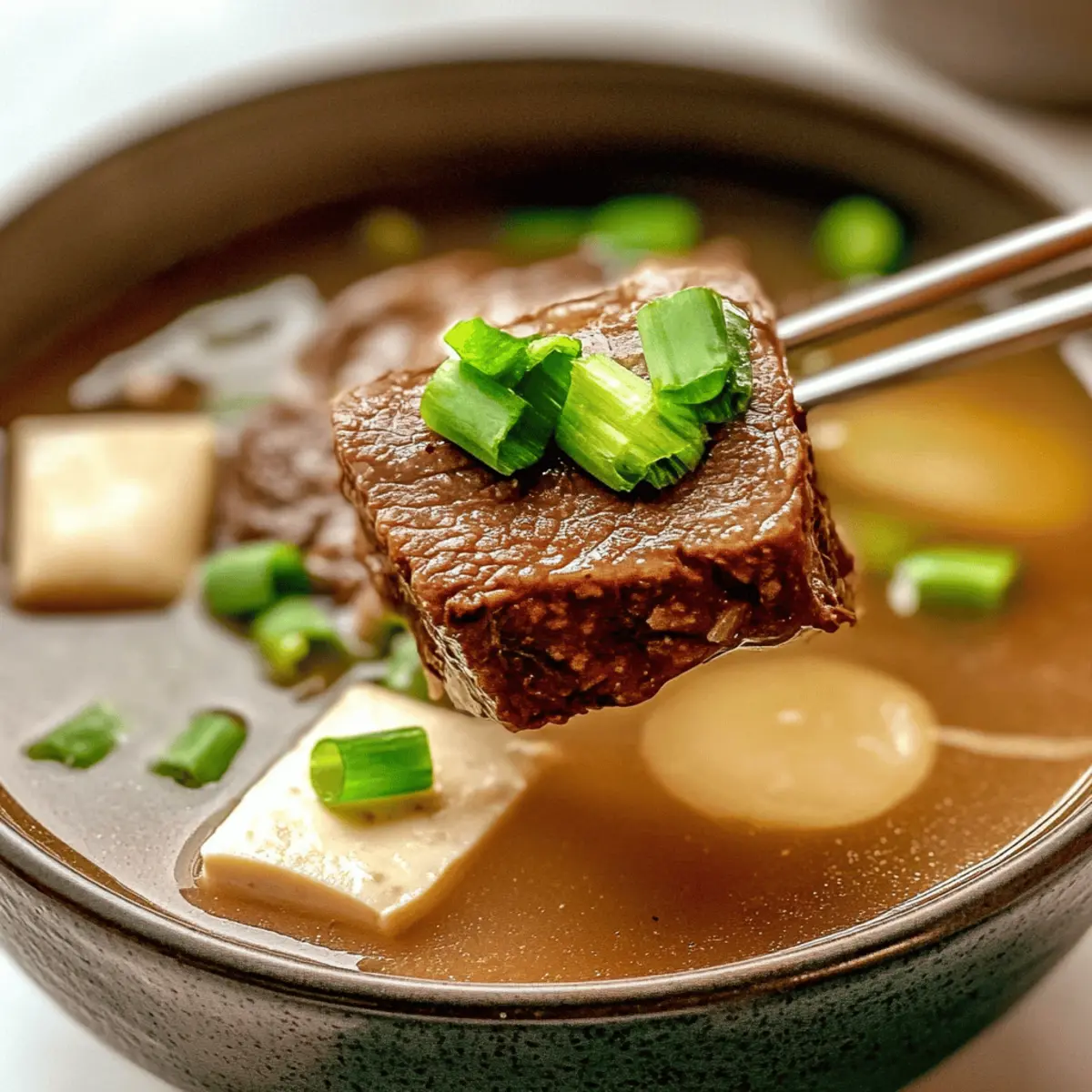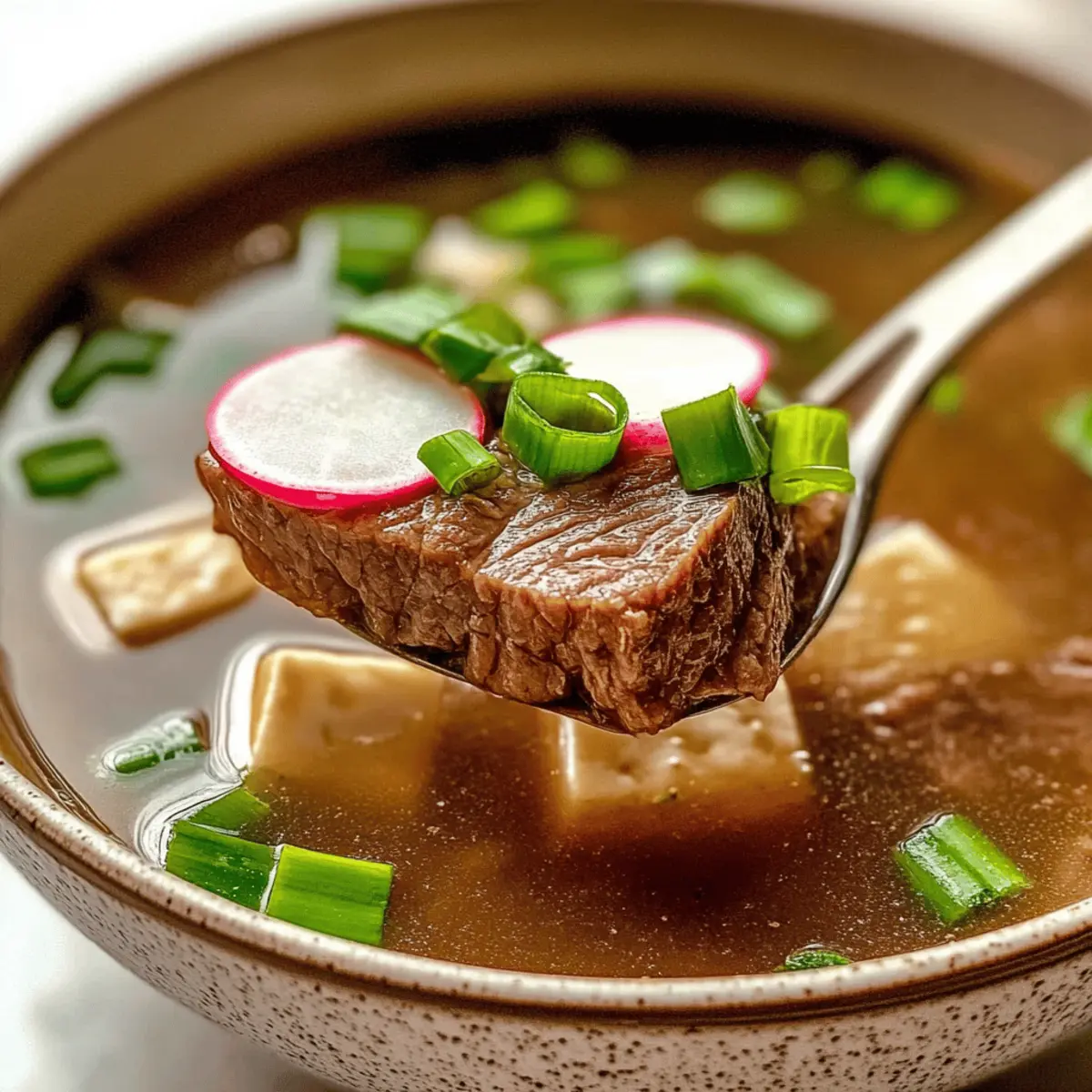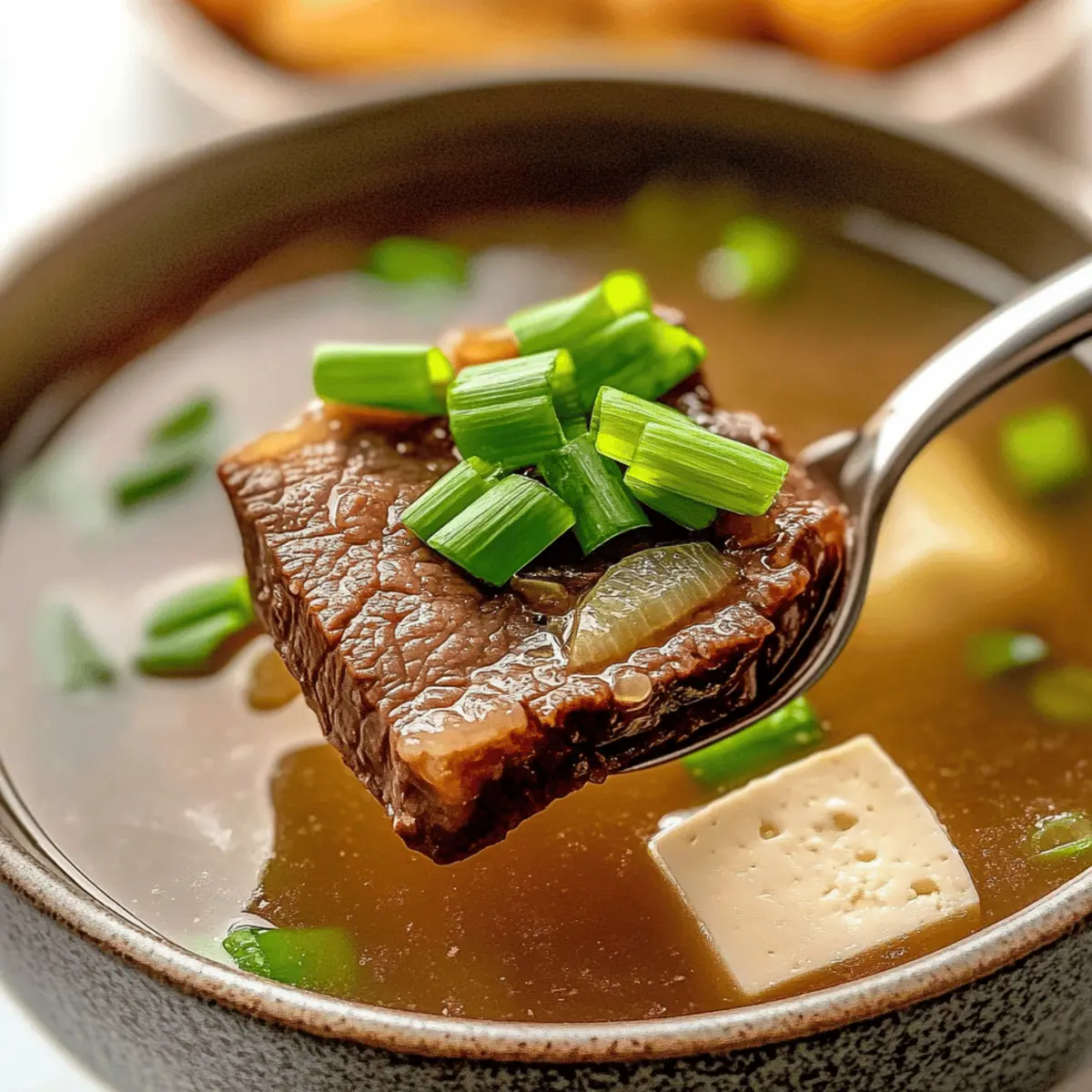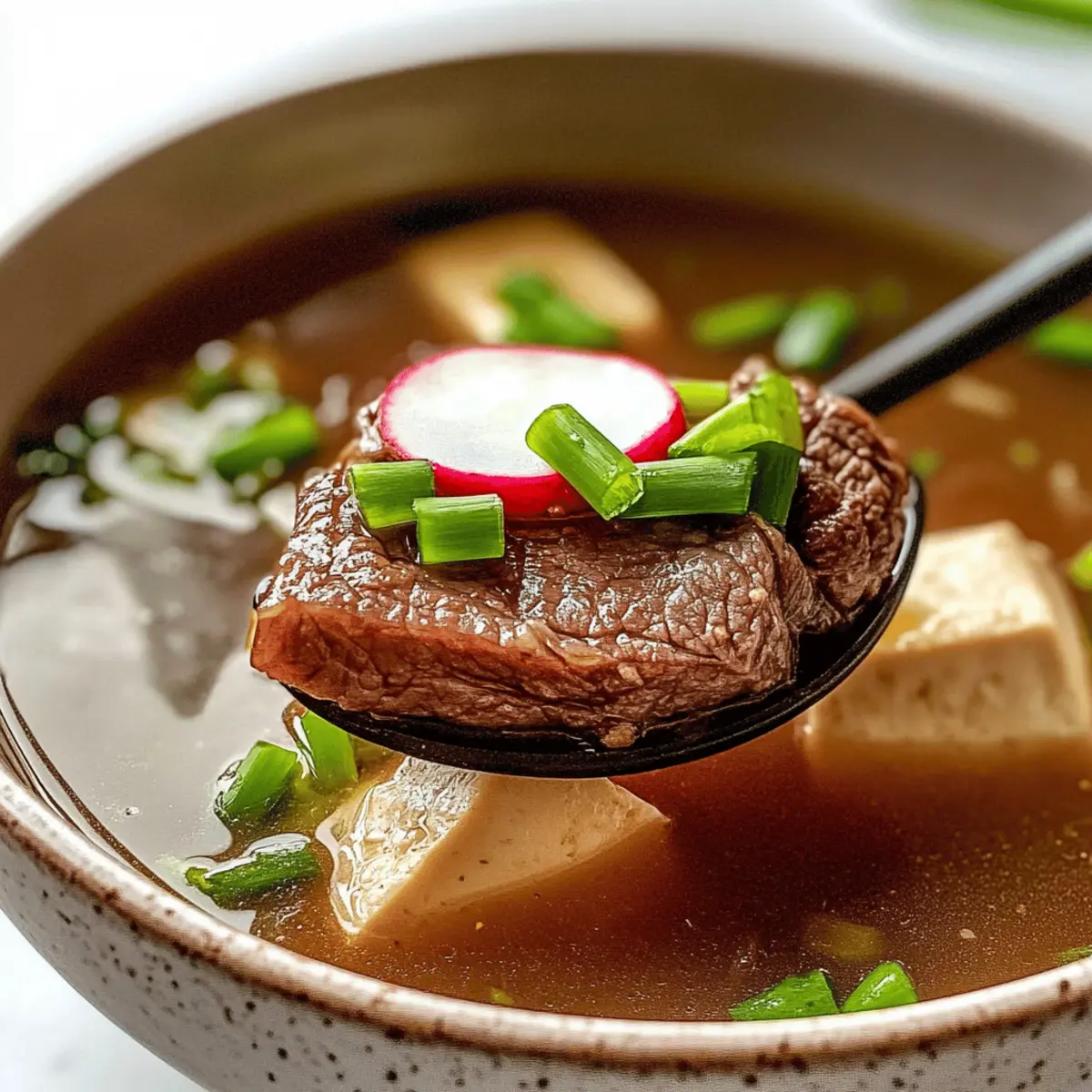As the chill of winter settles in, there’s nothing quite like the savory aroma of a bubbling pot of soup transforming your kitchen into a haven of warmth. Today, I’m excited to share my recipe for Korean Winter Soup, a comforting dish that brings together tender beef, soft tofu, and an array of aromatic vegetables simmered to perfection. This delightful soup is not only a quick prep solution for busy weeknights but also a nourishing alternative to those takeout nights you might be tempted by. Each spoonful wraps you in a cozy embrace, making it a go-to comfort food to ward off the cold. So, are you ready to dive into a bowl of pure bliss that’s perfect for sharing with friends and family? Let’s get cooking!

Why is Korean Winter Soup a must-try?
Comforting warmth: This soup is like a hug in a bowl, perfect for chilly nights!
Quick prep: With simple steps and minimal cooking skills, you’ll have dinner on the table in no time.
Flavor-packed: The rich broth, combined with tender beef and aromatic veggies, creates a deliciously savory experience.
Versatile: Easily adapt the recipe using tofu for a vegetarian option or substitute proteins based on your preference. If you’re looking for more comforting soups, don’t miss my recipes for Tuscan Ravioli Soup and Inflammatory Chicken Soup.
Nourishing ingredients: Each ingredient is carefully chosen to provide vitamins, protein, and healthy fats, making it a wholesome meal.
Crowd-pleaser: Serve it at gatherings or family dinners, and watch it disappear in a flash—it’s that good!
Korean Winter Soup Ingredients
• Get ready to savor every spoonful!
For the Broth
- Beef Short Ribs – Provides rich flavor and tender texture; can substitute with beef shank or oxtail for similar results.
- Onion – Adds depth of flavor as it caramelizes in the broth.
- Ginger – Infuses warmth and a slight spiciness; fresh is best for the most potent flavor.
- Garlic – Enhances aroma and taste; use fresh cloves for maximum goodness.
For the Vegetables
- Korean Leeks – Offer a distinct aromatic depth; substitute with regular leeks or a mix of green onions and chives.
- Radish – Contributes a subtle sweetness and texture, balancing the savory elements.
- Green Onions – Brighten the dish with freshness; add as a garnish for extra color.
For Seasoning
- Guk Ganjang (Korean Soup Soy Sauce) – Enhances umami flavor; substitute with regular soy sauce mixed with a bit of fish sauce or use tamari/coconut aminos for a gluten-free option.
- Sea Salt – Essential for seasoning; adjust to taste for the perfect balance.
For the Protein
- Tofu – Adds creaminess and is a great source of protein; look for firm or soft, depending on your preference.
Feel free to gather these ingredients and let the wonderful journey of making your Korean Winter Soup begin!
Step‑by‑Step Instructions for Korean Winter Soup
Step 1: Soak the Beef
Begin by soaking the beef short ribs in cold water for 1 hour in a large bowl. This will help draw out any blood and impurities, resulting in a clearer broth. If you’re short on time, you can alternatively flash boil the ribs for 5 minutes in simmering water, then skim off the liquid and proceed to the next steps.
Step 2: Prepare the Aromatics
While the beef is soaking, prepare your aromatics to enhance the flavor of your Korean Winter Soup. Peel and keep the whole yellow onion with the skin on for richer flavor, and slice your ginger, garlic, and green onions (including roots) into manageable pieces. Set these aside to add depth to your broth.
Step 3: Combine Ingredients in a Pot
Once the beef is soaked, drain and rinse it briefly under cold water. In a large stockpot, combine the cleaned ribs along with the aromatics you prepared and pour in 10 cups of water. This mixture will create a hearty broth, so make sure the ribs are submerged well before moving on.
Step 4: Bring to a Boil
Place the stock pot over medium-high heat and bring the mixture to a brisk boil. As it heats up, you’ll notice foam forming on the surface; be sure to skim this off with a ladle to ensure your soup remains clear. Once boiling, reduce the heat to maintain a gentle simmer.
Step 5: Simmer the Broth
Allow the soup to simmer uncovered for 1 hour. During this time, occasionally skim any remaining foam that rises to the top. The longer the soup simmers, the richer the flavors will become, giving you a delicious Korean Winter Soup brimming with warmth and comfort.
Step 6: Add the Radish
After the initial hour of simmering, it’s time to infuse the soup with some sweetness by adding the radish slices. Stir them in gently and let the soup continue to simmer for an additional 20 minutes. The radish will soften and lend a pleasant texture to the broth.
Step 7: Season the Soup
Once the radish is tender, discard the onion, garlic, and ginger pieces you cooked earlier. Now, season your broth with guk ganjang (Korean soup soy sauce) and a sprinkle of sea salt. For extra aroma, add finely chopped garlic. Allow the mixture to simmer for another 10 minutes to meld all the flavors.
Step 8: Garnish and Serve
Finally, before serving your hearty Korean Winter Soup, garnish with sliced green onions and a dash of black pepper for a touch of freshness. Serve hot, preferably alongside steamed rice or pickled vegetables for a truly comforting meal that warms both the body and soul!

Make Ahead Options
Korean Winter Soup is a fantastic option for meal prep, saving you valuable time during busy weeknights! You can prepare the beef short ribs by soaking them up to 24 hours in advance, which helps to enhance the clarity of the broth. Chop your aromatics—onion, garlic, ginger, and green onions—up to 3 days ahead and store them in an airtight container in the refrigerator for optimal freshness. If you prefer, you can also slice the radishes a day ahead. When you’re ready to serve, simply combine the prepped ingredients and follow the remaining steps. This way, you’ll enjoy the same delicious flavors while cutting down on overall cooking time!
What to Serve with Korean Winter Soup
A warm bowl of delightful soup is always better when paired with comforting sides that enhance the experience!
- Steamed Rice: A classic accompaniment, the fluffy textures of rice soak up the savory broth, creating a perfect harmony of flavors.
- Pickled Vegetables: A refreshing crunch that cuts through the richness of the soup, providing a bright, tangy contrast.
- Seasoned Seaweed: These crispy, salty bites offer a unique umami punch, complementing the soup’s depth of flavor.
- Kimchi: This spicy, fermented vegetable dish adds zing and probiotics, elevating your meal with additional layers of taste.
- Stir-Fried Vegetables: Featuring colorful and nutritious veggies, stir-fry brings freshness and a variety of textures alongside each hearty spoonful.
- Garlic Bread: For a fusion twist, garlic bread can be a delightful dipper, perfect for sopping up every last drop of the nourishing broth.
- Herbal Tea: A warm cup of green tea or chamomile balances the meal’s richness, promoting a cozy, satisfying finish.
- Sesame Cookies: A light sweet treat to round off the meal, these cookies mesh beautifully with the savory notes of the soup.
Korean Winter Soup Variations
Feel free to get creative and make this comforting soup your own with these enjoyable twists!
-
Vegetarian Delight: Substitute beef with large portobello mushrooms or seitan to create a hearty vegetarian version. The mushrooms lend a juicy texture while soaking up the rich broth.
-
Gluten-Free Goodness: Use tamari or coconut aminos instead of traditional guk ganjang (Korean soup soy sauce) for a gluten-free alternative. This substitution keeps the umami flavor intact, accommodating all diets.
-
Spicy Kick: Add sliced fresh chilies or a spoonful of gochujang (Korean chili paste) for a spicy flavor boost. Just a little bit transforms your warm soup into a sizzling sensation!
-
Flavorful Broth Boost: Enhance the depth by throwing in a dash of fish sauce or a few dried mushrooms during simmering. It infuses the soup with an amazing umami kick that’s hard to resist.
-
Texture Twist: Include some diced potatoes or sweet potatoes along with the radish for extra creaminess. This addition not only changes the texture but also amps up the heartiness of the dish.
-
Herbal Infusion: Toss in a handful of fresh spinach or bok choy just before serving for a burst of color and nutrients. The vibrant greens will add freshness to each spoonful of soup.
-
Extra Aromatics: Wrap a stalk of lemongrass and a few kaffir lime leaves in cheesecloth and add them to the broth while simmering. This gives your soup an exciting aromatic undertone that transports you straight to Asia.
For more comforting options, consider pairing this delicious soup with my Cabbage Tofu Soup or a warm bowl of White Bean Soup. Happy cooking!
How to Store and Freeze Korean Winter Soup
-
Room Temperature: It’s best to avoid leaving the soup out at room temperature for more than 2 hours to ensure food safety.
-
Fridge: Store leftovers in an airtight container in the refrigerator for up to 3 days. This will keep the Korean Winter Soup tasting fresh and delicious.
-
Freezer: For longer storage, freeze the soup in portions using freezer-safe bags or containers. It can last up to 3 months in the freezer without losing flavor.
-
Reheating: When ready to enjoy, thaw overnight in the fridge and reheat on the stove over low heat, stirring occasionally. You might need to add a splash of water to maintain the desired consistency.
Expert Tips for Korean Winter Soup
-
Broth Clarity: Skim the foam during simmering to maintain a clear broth. This simple step elevates the soup’s presentation and flavor.
-
Careful Seasoning: Gradually adjust seasonings, tasting as you go. This prevents over-salting and allows the flavors of the Korean Winter Soup to shine through.
-
Time-Saving Trick: Flash boiling the beef ribs can significantly reduce the soaking time, but be aware it might lead to a slightly less savory broth.
-
Vegetarian Twist: For a vegetarian Korean Winter Soup, replace beef with hearty mushrooms like portobello or protein-rich seitan, ensuring you maintain the rich broth flavor.
-
Storage Tip: Allow the soup to cool before transferring it to an airtight container for refrigeration. It stays fresh for up to 3 days and is perfect for meals on the go!

Korean Winter Soup Recipe FAQs
How do I select the best ingredients for my Korean Winter Soup?
Absolutely! For the beef, look for short ribs that have good marbling for richness in flavor. Fresh vegetables should be firm and vibrant—avoid any with dark spots or signs of wilting. When purchasing tofu, opt for firm or extra-firm varieties to avoid disintegration during cooking.
How should I store leftovers of my Korean Winter Soup?
You can store any leftovers in an airtight container in the refrigerator for up to 3 days. Just let them cool to room temperature before sealing. This way, your soup will stay fresh and flavorful for your next cozy meal!
Can I freeze Korean Winter Soup?
Very! To freeze, portion the soup into freezer-safe bags or containers once it has cooled completely. It can last up to 3 months in the freezer. Remember to label the containers with the date! When you’re ready to enjoy it again, simply thaw overnight in the fridge and reheat on the stove.
What are some common troubleshooting tips if my soup doesn’t turn out as expected?
If your broth is cloudy, it’s likely due to not skimming the foam during simmering. Be sure to skim the surface to keep it clear. If over-salted, add a sliced potato to soak up some saltiness; simmer for a few minutes, then remove. For under-seasoning, add guk ganjang a little at a time, tasting as you go.
Is this Korean Winter Soup suitable for people with dietary restrictions?
Absolutely! To make it gluten-free, simply substitute the guk ganjang with tamari or coconut aminos. For a vegetarian version, I recommend using large portobello mushrooms or seitan. Always check for allergies with any additional ingredients like fish sauce or tofu variations.

Cozy Up with This Heartwarming Korean Winter Soup Recipe
Ingredients
Equipment
Method
- Soak the beef short ribs in cold water for 1 hour, or flash boil for 5 minutes if short on time.
- Prepare the aromatics: Peel and slice the onion, ginger, garlic, and green onions.
- Combine the soaked beef and aromatics in a stockpot with 10 cups of water.
- Bring to a boil over medium-high heat, skimming foam from the surface.
- Simmer uncovered for 1 hour, skimming any remaining foam.
- Add radish slices and simmer for an additional 20 minutes.
- Discard onion, garlic, and ginger; season broth with guk ganjang and sea salt.
- Garnish with sliced green onions and serve hot.

Leave a Reply